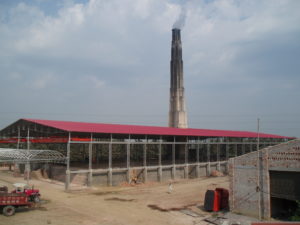
Photo credit: Uma Rajarthnam
Brick kilns are a leading cause of industry-caused air pollution. They are comprised of a range of designs that heat green clay bricks and fire them into the finished bricks used for building construction. Depending on the type of kiln, the output from them can produce a substantial amount of air pollution.
Air pollution from kilns can range between 10-30% depending on where the kilns are located and their economic viability. Therefore modernizing the designs and fuel types for kilns are significant factors in reducing the air pollution from the brick production industry. Converting Bull’s Trench kilns to Zigzag kilns and switching from coal-burning kilns to gas-powered ones are two of the changes the industry is making to improve air quality.
Kiln Types
There are many styles of kilns, but the majority of them are Bull’s Trench kilns. Kilns are often seasonally operated from November to June or July, taking a break from operating in the rainy season. Seventy percent of kilns currently in operation are Bull’s Trench. Bull’s trench kilns are in continuous use. Zigzag kilns are more efficient than Bull’s Trench because of how airflow paths are directed through the baking bricks.
In tunnel kilns, like a Bull’s Trench or Zigzag kiln, bricks can be covered, not sundried, to be run in continuous operation. Downdraft and Clamp kilns are both batch operation kiln types. One set of bricks goes in at a time and the kiln needs to heat and cool fully for each batch of bricks.
A Natural Draught Zigzag firing kiln is a moving fire kiln in which the fire moves in a closed rectangular circuit through the bricks stacked in the annular space between the outer and the inner wall of the kiln. It has many similarities with FCBTK technology. The main difference is the zigzag airflow path. Some regions are already transitioning to prioritizing the switch to ZigZag Kilns, such as the National Capital Region of India, and kiln update methods in Nepal. Here is a description in Hindi.
Fuel Updates
Fuel is also an important factor in kiln operation. Coal-powered kilns produce more air pollution than gas-powered kilns. So, switching kilns from coal to gas improves local air quality impacts. However, these updates are difficult in regions where there is not yet existing infrastructure for gas lines.
Stakeholder Support
Stakeholder groups that influence the air quality outputs from brick kilns include kiln operators, consumers building with the bricks, the government agencies providing technical inputs and regulatory perspectives, and the donor or funding agencies supporting the technology updates to cleaner and more efficient kilns.
Barriers preventing transitions to more efficient kiln models include a lack of capital for the physical upgrades, support for training kiln workers, a general lack of infrastructure for natural gas fuel, and the uncertainty of trying something new when the security of you’re livelihood is at stake. Zigzag kilns require more skilled labor than Bull’s Trench kilns, so investment needs to be made in training operators.
There are also financial barriers for kiln operators to invest in updated kiln models. Funding agencies can support kiln efficiency by providing financial capital to operators switching to clearer technologies. Collaboration between NGOs, government policy, and kiln operators have the potential to dramatically reduce air pollution from the brick kiln industry.
Regulatory and technology updates are the main drivers for air pollution reductions in brick kilns. From a policy perspective, switching from Bull’s Trench to Zigzag kilns and from coal fuel to natural gas are the two most important updates. Governments can support clean air standards in kiln operation by implementing policies to update kilns to more efficient models, such as Zigzag kilns, and transitions to cleaner fuels, such as gas-powered kilns preferred over coal-burning ones.